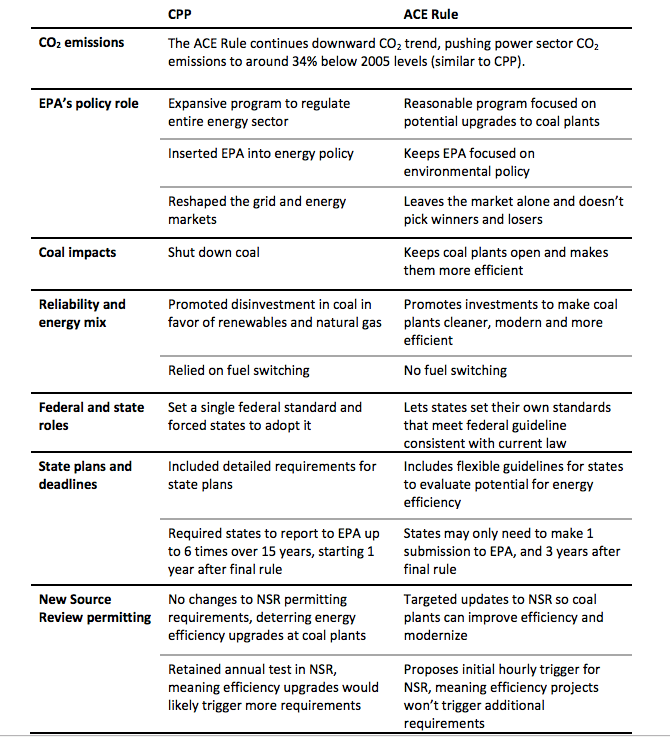The U.S. Environmental Protection Agency (EPA) recently proposed a new rule to reduce greenhouse gas (GHG) emissions from existing coal-fired electric utility generating units and power plants across the country. This proposal, entitled the Affordable Clean Energy (ACE) Rule, establishes emission guidelines for states to use when developing plans to limit GHGs at their power plants.
The ACE Rule replaced the prior administration’s overly prescriptive and burdensome Clean Power Plan (CPP) and instead empowers states, promotes energy independence, and facilitates economic growth and job creation.

The EPA has released its own “side-by-side comparison” of the two plans, available here.
Pursuant to President Trump’s Executive Order 13873, which directed Federal agencies to review burdensome regulations, the EPA undertook a review of the CPP. Many believed the CPP exceeded EPA’s authority under the Clean Air Act, which is why 27 states, 24 trade associations, 37 rural electric co-ops, and three labor unions challenged the rule. Additionally, the Supreme Court issued an unprecedented stay of the rule.
“The ACE Rule would restore the rule of law and empower states to reduce greenhouse gas emissions and provide modern, reliable, and affordable energy for all Americans,” said EPA Acting Administrator Andrew Wheeler. “Today’s proposal provides the states and regulated community the certainty they need to continue environmental progress while fulfilling President Trump’s goal of energy dominance.”
The proposal will work to reduce GHG emissions through four main actions:
1. ACE defines the “best system of emission reduction” (BSER) for existing power plants as on-site, heat-rate efficiency improvements;
2. ACE provides states with a list of “candidate technologies” that can be used to establish standards of performance and be incorporated into their state plans;
3. ACE updates the New Source Review (NSR) permitting program to further encourage efficiency improvements at existing power plants; and
4. ACE aligns regulations under CAA section 111(d) to give states adequate time and flexibility to develop their state plans.
The proposed ACE Rule is informed by more than 270,000 public comments that EPA received as part of its December 2017 Advance Notice of Proposed Rulemaking (ANPRM).
“EPA has an important role when it comes to addressing the CO2 from our nation’s power plants,” said Assistant Administrator for the Office of Air and Radiation Bill Wehrum. “The ACE rule would fulfill this role in a manner consistent with the structure of the Clean Air Act while being equally respectful of its bounds.”
EPA’s regulatory impact analysis (RIA) for this proposal includes a variety of scenarios. These scenarios are illustrative because the statute gives states the flexibility needed to consider unit-specific factors – including a particular unit’s remaining useful life – when it comes to standards of performance. Key findings include the following:
• EPA projects that replacing the CPP with the proposal could provide $400 million in annual net benefits.
• The ACE Rule would reduce the compliance burden by up to $400 million per year when compared to CPP.
• All four scenarios find that the proposal will reduce CO2 emissions from their current level.
• EPA estimates that the ACE Rule could reduce 2030 CO2 emissions by up to 1.5% from projected levels without the CPP – the equivalent of taking 5.3 million cars off the road. Further, these illustrative scenarios suggest that when states have fully implemented the proposal, U.S. power sector CO2 emissions could be 33% to 34% below 2005 levels, higher than the projected CO2 emissions reductions from the CPP.
EPA will take comment on the proposal for 60 days after publication in the Federal Register and will hold a public hearing.
More information including a pre-publication version of the Federal Register notice and a fact sheet are available here.
Filed Under: News




